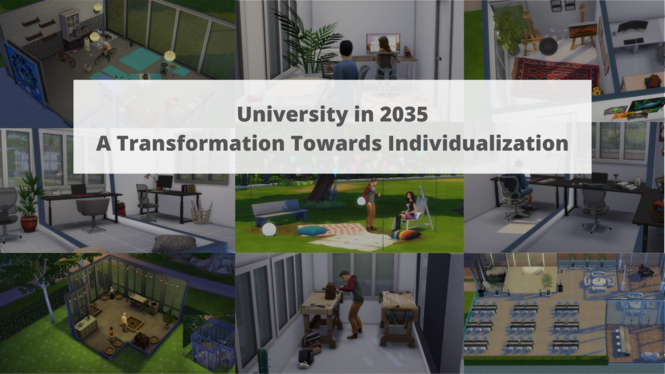Scenarios of University in 2035
A transformation toward individualization.
A transformation toward individualization.
Addressing the future of your own university when still a student there is a unique opportunity to change the existing structures according to one's own wishes and needs. Information and Communication students between the ages of 21 and 25 who were enrolled in the course “Futures Literacy” at Stuttgart Media University in Germany were able to do just that when they examined the future of universities as a topic for their class project during the Winter 2021 semester. Supervised by Professor Dr. Tobias Seidl (@drseidlt), an alumnus of Institute for the Future’s Foresight Essentials training, we mainly used the futures thinking methods of IFTF to develop four alternative scenarios and write a final report, which included recommendations for the university faculty council on how to prepare for possible future scenarios of higher education in 2035.
Each student first individually researched and collected signals of change and trends/drivers, which were then compiled with everyone else’s. Signals included stories of increased funding for distance learning, and drivers included the rising popularity of “flipped classrooms” due to the increasing number of digital resource libraries for schools. Next, each student combined several signals and trends to create four of their own future scenarios. Based on what our scenarios focused on, groups were formed by an interest in a specific trend or theme, such as increasing internationalization, accessibility, individualization, or digitization. Our group of three students chose to focus on the theme of individualization. We then analyzed all our individually written scenarios through the lens of our chosen topic, looked for similarities and things we could all agree on, and combined them into four new overarching and comprehensive future scenarios. Since four groups were formed in the course, a total of 16 different future scenarios were created. The final report also included instructions for things that needed to be accomplished or established in order for each future scenario to become a reality. Writing a scenario that we didn’t want to happen was possible, but since proposing recommendations on how to achieve the future scenarios was part of the final report, we mostly chose to write preferred scenarios.

In our group’s scenarios, university life in 2035 is characterized by adapting and tailoring situations to the individual personal needs of students. We decided on four distinct scenarios, which we summarized as the following:
Our first scenario envisions a future where students can build their own learning modules and degree programs based on their individual tastes, by freely piecing together what classes they wish to take. Depending on the characteristics of the selected modules, a degree with a certain focus is awarded.
Our second scenario focuses on pedagogy. Above all, practical teaching methods are to be promoted. A new and thriving feedback culture among lecturers and students makes choosing modules and developing them easier. Soft skills are taught in compulsory courses to ensure personal development. For more individuality, students are able to initiate their own projects as a module instead of doing only what professors wish.
In our third scenario, modules can be taken in different universities throughout Germany in order to promote student exchange. This promotes flexibility and individuality, and students have the additional chance to get to know new environments and professors.
Our last scenario addresses the spatial restructuring of the university. We are sure that lectures will continue to be at least partially online and that learning from home will still be popular. Because of this shift, students will need new incentives to keep going to campus. Such incentives could include the use of private rooms for online lectures on campus instead of the library, where talking is discouraged, which makes collaboration difficult. Working on group projects is easier in specially equipped rooms or more casual meet-up spaces on rooftop terraces or green lawns around campus. These more flexible spaces allow students to work more efficiently and with greater focus. Students are optimally supported within such spaces and by the equipment available on campus. A big hurdle is, of course, the high costs.
All scenarios have one thing in common: More individualization through different means, be it changing locations for a semester or just new spaces to study on campus. We think implementing certain changes, like making campuses more green and developing a more elaborate feedback culture will be easy. A first step to freely choosing modules and eliminating study programs is doing just that for each of our three faculties.
Because our team was new in the field of futures thinking, we had difficulties in the initial application of the new methods and needed to get used to them first. Looking into the distant future and thinking outside the box was something we had to learn over time. The construct of time, especially the future, is very abstract, which makes it difficult to imagine. The diversity and endless possibilities of the future made it hard for our team to choose and focus on one main topic.
Nevertheless, our team took on the new challenges and successfully used the new methods and ideas to develop future scenarios. Our goal is for colleges and universities to draw inspiration from these scenarios and recommendations, to see from students’ perspectives, and to take action for change. As a next step, our team will further develop and sharpen the future scenarios during the Summer 2022 semester and then present them in various events such as "LERNTEC", an international trade fair and congress in Karlsruhe, Germany.